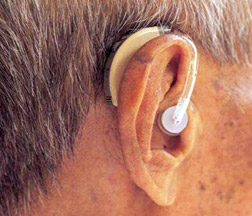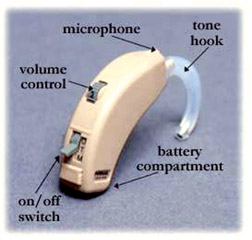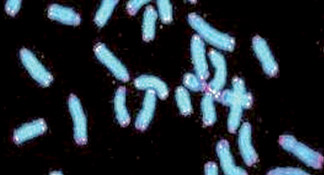|
Health Watch
Hearing aids for children
Lakna MENDIS
To get the best results out of a hearing aid, you and your child
should meet a certified audiologist to learn what a hearing aid can and
cannot do, and how to operate it.

It is important to understand how hearing aids work and how to
select, operate and care for them. Properly working hearing aids and
consistent use of hearing aids will help your child hear and develop
good speech and language skills.
How does a hearing aid work?
All behind-the-ear hearing aids have a microphone, amplifiers and
processors, a volume control, a tone hook, an earmould, an on/off
switch, and a battery compartment.
The sound enters through the microphone, is amplified and shaped by
the processor, and is directed out the tone hook and through the
earmould into your child's ear.
The earmould is specifically made to the shape of your child's
ear. Earmoulds need to be replaced fairly often as your child's ear
grows.
What kind of hearing aid is best for your child?
It is important to work with your audiologist and early intervention
team to evaluate your child's needs. Since very young children cannot
adjust their own hearing aids, the hearing aid selected for infants must
be easily manipulated and monitored by parents and caregivers.
 As
your child grows and develops and can respond to more sophisticated
tests, hearing aids are adjusted accordingly. Therefore, hearing aids
that can be easily adjusted for frequency response, amount of
amplification, and maximum limits of amplification are desirable. These
devices are typically digital hearing aids. As
your child grows and develops and can respond to more sophisticated
tests, hearing aids are adjusted accordingly. Therefore, hearing aids
that can be easily adjusted for frequency response, amount of
amplification, and maximum limits of amplification are desirable. These
devices are typically digital hearing aids.
In educational and home settings, children frequently connect their
hearing aids to hearing assistive technology systems. Therefore, the
hearing aid prescribed should have special features (telecoil and direct
audio input capability) that will allow for this connection.
Several types of hearing aids are available; the appropriate type
depends on your child's individual needs and skills. The behind-the-ear
(BTE) hearing aid is the type of hearing and most commonly recommended
for infants and young children for a number of reasons, including:
It accommodates various earmould types
The earmould detaches and can be easily remade as the child grows
The earmould is easy to handle and can be easily cleaned.
Parents and caregivers can easily do a listening check and make
adjustments.
It can accommodate a wide variety of hearing losses.
It can be made with direct audio input or a telecoil, so it can be
used with other listening devices.
The earmoulds are made of a soft maternal that is safer and more
comfortable for tiny ears.
In-the-ear (ITE) styles are usually reserved for adults and older
children. Once you have selected a hearing aid, the audiologist will
carefully set the hearing aid using the results of your child's hearing
tests.
Keeping hearing aids on your child
It is very important that children with hearing loss use their
hearing aids as much as possible. A child who has been wearing hearing
aids consistently since infancy will probably wear them without
resistance. Children who have not been consistent hearing aid wearers
may be more of a challenge.
Start by putting the hearing aids on your child while you are engaged
in a fun activity and increase the amount of time until your child is
wearing the hearing aids during all waking hours.
Young children should learn that only an adult should put the hearing
aids on and take the hearing aids off. Older children may be more
interested in their hearing aids if they are able to provide input into
the color of their earmould or hearing aid.
There are several ways to secure the hearing aids to your child's
ears. Some ideas include two-sided toupee tape, Huggie Aids, lightweight
caps and headbands, fishing line and a safety pin, and hearing aid
clips. Your audiologist will help you find the best method for your
child.
Telomeres in human health
Dr. Senarath Tennakoon
|

Elizabeth Blackburn |
Telomeres are specialised DNA sequences that are stretches of DNA
found at the ends of chromosomes... A telomere consists of up to
hundreds of copies of a short repeated sequence (5'-TTAGGG -3' in
humans), which is synthesised by the enzyme telomerase in a mechanism
independent of normal DNA replication.
|

The telomere DNA |
The telomere DNA forms a special secondary structure. Its function is
to protect the ends of chromosome from degeneration.
Elizabeth Blackburn, a professor of Biology and physiology,
University of California, shared a Nobel Prize in 2009 for her work on
telomeres and their links with human health.
Telomere length can be an indicator of one's health status as
shortening is observed in aging and in some diseased conditions like
heart diseases and cancer. Bone marrow failure too has caused a
shortening of the telomeres. Further, chronic high stress and smoking
too are among the risk factors that could lead to shortening of
telomeres. As such changes in one's lifestyle would lead to better
health.
A simple test for checking the length of telomeres from a sample of
blood has been devised. It measures the telomere length of white blood
corpuscles. But it can be performed with any cell type for instance on
samples taken from saliva or buckle mucosa.
Causes of indigestion
S R Balachandran
Last month a friend of mine (45 years old) had a severe chest pain
irritating and burning session in the food path. However, the doctors
confirmed that there was no heart attack and it was mainly due to
continued indigestion which could be cured by proper eating habits.
Reasons:
|

The torment of indigestion |
a. Fast eating - gobbling without proper chewing
b. Continued tension
c. Intake of spicy, oily, animal fatty, fast foods in plenty
d. Inadequate intake of water
e. Intake of water whilst having meals
f. Bad eating habits - heavy dinner, eating between 11.00 pm. and 3.00am
g. Lack of exercises
h. Obesity
i. Consumption of liquor, smoke etc.
j. Taking of strong drugs violating doctor's instructions (eg. Taking
them in the empty stomach) in the morning.
There is a valve between our food path and the stomach. It opens and
closes when we are in the process of eating. The valve will remain
opened if spicy, oily, and indigestible food is taken in excess. In this
case partly indigested food and the acid in the stomach will get vomited
through the mouth, thereby burning the food path.
This strong acid, if swallowed frequently results in ulcer, holes in
the intestine.
Prevention
* Lead a balanced life, Proper exercises, Rest (both body and
mental), Good sleep etc.
* Draw backs mentioned in the previous paragraph be corrected. * Take
adequate water (10 glasses per day)
* Avoid tea and coffee
* Never take soda, aerated waters and bottled, artificially sweetened
drinks
* Take selected fruits (eg. Plantains) and vegetables
* Take adequate milk, butter milk and selected natural fruit juices
* Meditation is good, breathing exercises are excellent, In Yoga it
is called Pranayamam and Chi kung in Chinese.
* Keep the body weight under control
* Create a sense of humor and keep your mind relaxed.
Twenty years dedicated to counselling
Pandula Caldera
In 1974 Joan de Mel, a Befriender from Samaritans UK, married to late
Bishop Lakdasa de Mel founded Sri Lanka Sumithrayo, initially in
Colombo. It was at the request of a number of Doctors from the General
Hospital Colombo, who were distressed at the many attempted suicides in
the hospital.
The organization was incorporated by Act of Parliament No. 10 of 1986
under section 3 (d) empowering it to set up branches.
|

The toll of emotional stress |
The branch in Kandy was established in 1978 and Bandarawela
established in 1991. At the same time the need for a Centre South of
Colombo was felt.
Two committed Volunteers from Moratuwa working at Colombo decided to
look for a place in Moratuwa or Panadura. An old house with a large
garden, was located on Galle Road Panadura a part of which was taken on
rent and the Sri Lanka Sumithrayo fourth Branch was set up at Panadura,
20 years ago in August 1991. Since Panadura is the only Centre along the
coast, South of Colombo, it has a comparatively large reach.
A Senior Volunteer transferred temporarily from Colombo, trained us
in the skills of listening and befriending and together with another
Volunteer, functioned as founder Co-Directors. Of the initial core group
of 13 volunteers, we are proud to say that 7 volunteers are still on
roll.
After 10 years we built and moved into our own premises in 2001, in
the adjoining block of land donated by a well-wisher. They are open 365
days of the year from 9 am to 3 pm. Their membership varies between 25
and 30 volunteers at any given time.
Their volunteers are specially trained. Their service is completely
free of charge. They maintain 100% Non Judgmental Caller Confidentiality
with no religious or political affiliations. Their funding is entirely
local, thanks to donors who help them from time to time and fund raisers
such as sales and musical shows.
Befriending is done face to face, over the phone, or by letter. At
the Base Hospital Panadura, persons who have attempted suicide are
befriended by them trained for Hospital befriending. Outreach in the
form of programs for Schools, Children's homes and Elders' homes are
also a part of their work.
They have found very often, that a sympathetic listening ear is all
that a distressed person really wants. This unconditional emotional
support is a soothing balm much more potent than expensive medication,
to those passing through an emotional crisis and who may be in danger of
taking their own lives. No one is ever turned away. Their committed
volunteers often stay well past closing time when required. Clock
watching is not in their books!
So what do they gain from this exercise? Learning and immense
self-growth, which money cannot buy, or get from a book. The look of
happiness on the faces of a couple who came perhaps thinking of a
divorce and have decided to stay together is often their reward! If they
have managed to avert a suicidal person from swallowing grammoxone, they
have saved a valuable life.
Over the years they have changed and become better human beings,
mothers and fathers have become Grands, and their priorities have also
changed. One volunteer remarked, “I should have joined Sumithrayo before
I got married – then I would have raised my children differently.” They
do take long leave, but are drawn to return to serve. That is the love
they have for the organisation and the unfailing commitment of their
volunteers.
We can now look objectively at ourselves and admit to our many
faults. They have learnt the value of time. They are much more humble,
their own troubles seem trifling when compared to with what they hear
from their callers.
They tend to be more patient and are better able to handle negative
emotions like anger, hatred and jealousy.
Dilemmas of HIV patients
S R Balachandran
It could be observed sexual violence/abuses on woman and children and
homosexuality, lesbianism are on the increase all over the world
including Sri Lanka. On a survey taken in the USA it is revealed that 5%
lesbianism among young girls of 17 in 2002 has increased to 11% in 2010.
In Sri Lanka proper statistics are not available as homosexually is
illegal. Several countries had recognized homosexually as legal and
marriages are also allowed in churches. In India supreme courts had
ruled out that homosexuality should not be considered as illegal. We may
face similar situation shortly requesting for recognition and our
religious leaders intellectual, social workers should come to a firm
decision. It should be noted that homosexuality is also cause HIV.
HIV rate in Sri Lanka is increasing. Regrettably it appears that our
people are not well aware of the danger of HIV and are reluctant to use
safely measures.
In a recent survey taken in UK it was revealed that the younger
generation does not prefer to use safety measures in sex (it is like
chewing a wrapped chocolate)
I quote below problems faced by HIV patients
1. No cure is available (like hypertension, heart ailments, diabetes
: it could be controlled with expensive drugs)
2. Agony faced at the latter stage is terrible
3. Hatred by the society - I understand in Sri Lanka some villages
attempted to set fire to the house of HIV patient who received same from
her husband
4. Innocent children are badly affected
5. No job opportunities though services of HIV patients could not be
terminated but however co-workers will not prefer to cooperate with
them.
6. Raped victims face the danger of HIV - they have to be given
expensive medical treatment before any other action.
7. No sympathy from others even from medical staff in the hospital -
in a survey in India HIV patients complain that they face harassment in
the hands of medical staff who consider them as animals.
8. Blood transfers become unsafe. There are well-known cases in Sri
Lanka.
9. Some HIV patients prefer to spread to other as revenge against the
society.
It is the duty of the parents to educate their children. In UK
parents teach their children about good touch and bad touch. You should
watch children's behaviour and should take early action.
In India there was a proposal to obtain medical certificate before
marriage showing that both parties are clear of HIV. However, this was
overruled due to the following reasons.
1. Bogus certificates are possible
2. A person who is clear of HIV now may receive it after sometime
3. Undue publicity could be given for the victims.
However, some Indians Hindu temple insists on this certificate to
have weddings in their halls - good move.
Therefore I appeal to the younger generation to lead a clean life (no
smoke, no drinks, no drugs and no unsafe sex) for a healthy future. |



